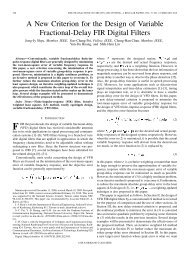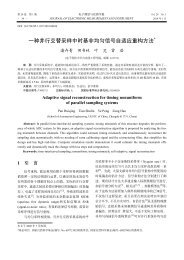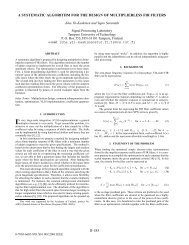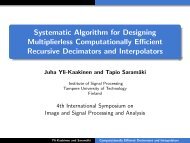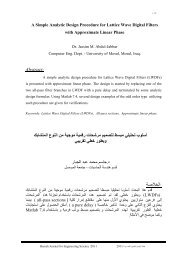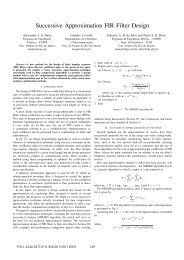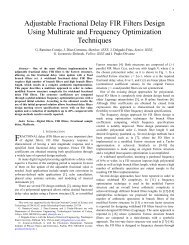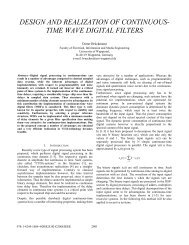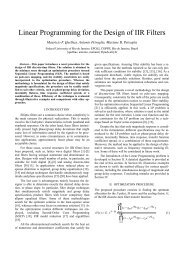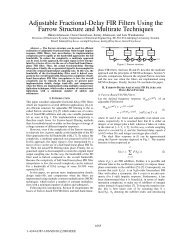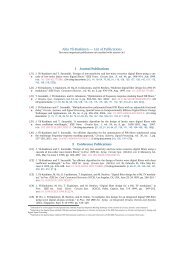Wave digital filters with minimum multiplier for discrete Hilbert ...
Wave digital filters with minimum multiplier for discrete Hilbert ...
Wave digital filters with minimum multiplier for discrete Hilbert ...
Create successful ePaper yourself
Turn your PDF publications into a flip-book with our unique Google optimized e-Paper software.
ARTICLE IN PRESSSignal Processing 86 (2006) 3761–3768www.elsevier.com/locate/sigpro<strong>Wave</strong> <strong>digital</strong> <strong>filters</strong> <strong>with</strong> <strong>minimum</strong> <strong>multiplier</strong> <strong>for</strong> <strong>discrete</strong><strong>Hilbert</strong> trans<strong>for</strong>mer realizationS.A. Samad a, , A. Hussain a , D. Isa ba Department of Electrical, Electronic and Systems Engineering, Faculty of Engineering, National University of Malaysia (UKM),43600 UKM Bangi Selangor, Malaysiab Faculty of Engineering and Computer Science, University of Nottingham, Malaysia Campus, Jalan Broga, 43500 Semenyih,Selangor Darul Ehsan, MalaysiaReceived 1 December 2005; received in revised <strong>for</strong>m 9 March 2006; accepted 14 March 2006Available online 5 April 2006AbstractThis paper describes the design of wave <strong>digital</strong> <strong>filters</strong> <strong>for</strong> <strong>discrete</strong> <strong>Hilbert</strong> trans<strong>for</strong>mer realization. A method <strong>for</strong> designingreal and complex half-band wave <strong>digital</strong> <strong>filters</strong> (WDFs) <strong>with</strong> a <strong>minimum</strong> number of <strong>multiplier</strong>s is af<strong>for</strong>ded where the<strong>multiplier</strong> coefficients <strong>for</strong> the adaptors are calculated directly from the <strong>digital</strong> domain transfer functions. This techniqueuses the equations derived <strong>for</strong> a class of infinite impulse response (IIR) filter and hence avoids the conventional techniqueof synthesizing a WDF from an analogue reference filter. The selection of the adaptor configuration is determined from the<strong>multiplier</strong> coefficient values. A <strong>minimum</strong> <strong>multiplier</strong> realization of real half-band WDFs can be obtained to meet the lowpass<strong>digital</strong> filter magnitude specifications. By applying a trans<strong>for</strong>mation equation, a complex half-band WDF suitable <strong>for</strong>the realization of the <strong>discrete</strong> <strong>Hilbert</strong> trans<strong>for</strong>mer <strong>with</strong> a <strong>minimum</strong> number of <strong>multiplier</strong> is obtained.r 2006 Elsevier B.V. All rights reserved.Keywords: <strong>Wave</strong> <strong>digital</strong> <strong>filters</strong>; <strong>Hilbert</strong> trans<strong>for</strong>mer; Minimum <strong>multiplier</strong>1. Introduction<strong>Wave</strong> <strong>digital</strong> <strong>filters</strong> (WDFs) represent a class of<strong>digital</strong> <strong>filters</strong> that are closely related to classical filternetworks, usually lossless <strong>filters</strong> inserted betweenresistive terminations. For every WDF, therecorresponds a reference analogue filter from whichit is derived. The analogy between a WDF and itsreference network is based not on the use ofvoltages and currents as the signal variables but Corresponding author. Tel.: +603 8921 6331;fax: +603 8921 6146.E-mail address: sas@ieee.org (S.A. Samad).the traveling wave quantities of classical electriccircuits. A variety of WDFs are available and manyhave found applications in systems requiring <strong>digital</strong><strong>filters</strong>. This is due to the good sensitivity propertiesof the WDFs obtained from a properly designedanalogue filter that is both passive and lossless. Thisproperty is preserved in the <strong>digital</strong> domain by thestructures of the WDFs which emulate the analogue<strong>filters</strong>. The good sensitivity properties translate toreduced accuracy requirement <strong>for</strong> the coefficientwordlength and a good dynamic range per<strong>for</strong>mance[1–3].Filters are classified according to the characteristicsof their frequency response. Real half-band0165-1684/$ - see front matter r 2006 Elsevier B.V. All rights reserved.doi:10.1016/j.sigpro.2006.03.005
3762ARTICLE IN PRESSS.A. Samad et al. / Signal Processing 86 (2006) 3761–3768<strong>filters</strong> are usually a pair of <strong>filters</strong> <strong>with</strong> one having alow-pass response occupying the lower half of theuseful <strong>digital</strong> frequency band, and the other <strong>with</strong> ahigh-pass response occupying the upper half of theuseful <strong>digital</strong> frequency band. These <strong>filters</strong> areusually used in pairs <strong>for</strong> applications such as insubband coding. Complex half-band <strong>filters</strong>, on theother hand, are often used to realize the <strong>discrete</strong><strong>Hilbert</strong> trans<strong>for</strong>mer. The <strong>discrete</strong> <strong>Hilbert</strong> trans<strong>for</strong>merarises in a variety of practical applications,including inverse filtering, complex representations<strong>for</strong> real bandpass signals, single side-band modulationtechniques and spectral analysis. Both infiniteimpulse response (IIR) and finite impulse response(FIR) <strong>filters</strong> can be used to realize these <strong>filters</strong> [4].For applications requiring strict linear phase, FIR<strong>filters</strong> are usually used [5]. However, when the phaserequirement is not as stringent, the IIR filter is abetter choice as it requires fewer coefficients torealize the same transfer function as an FIR filter[6]. Using IIR <strong>filters</strong> are especially advantageous inrealizing low-cost and low-power devices.<strong>Wave</strong> <strong>digital</strong> <strong>filters</strong> have been shown to beapplicable to the design of real half-band <strong>filters</strong>[7–11]. Many of the methods rely on deriving theWDF structure from reference analogue lattice<strong>filters</strong> and the realizations may not be optimum interms of the number of <strong>multiplier</strong>s required given afilter order. In addition, complex realizations arenot shown <strong>for</strong> these real <strong>filters</strong>.For complex half-band WDFs the design techniquerelies on deriving the WDF structure fromreference analogue <strong>filters</strong> having the complexresponse [12]. For these filter types, the correspondingWDF structures are obtained using an elementto element translation from the analog to the <strong>digital</strong>domain and interconnecting the <strong>digital</strong> elementsusing the appropriate adaptors. A purely <strong>digital</strong>approach showing the resulting effects in both themagnitude and phase responses has not been shown.In this paper, a purely <strong>digital</strong> approach isintroduced to design real and complex half-bandWDFs. The transfer functions <strong>for</strong> a class of IIRfilter are used to obtain all-pass WDF structureswhich are then used to obtain real half-band <strong>filters</strong>.Next, complex half-band filter WDFs are obtainedfrom real half-band WDFs by applying a trans<strong>for</strong>mationequation. The adaptor selection is determinedfrom the <strong>multiplier</strong> coefficient values whichmay differ <strong>for</strong> the real and complex WDFs.This paper is organized in the following manner:Section 2 details the design methodology of real andcomplex IIR <strong>filters</strong>, Section 3 presents the designparameters of wave <strong>digital</strong> <strong>filters</strong>, Section 4 gives anexample of the proposed technique while theconclusion is presented in Section 5.2. Designing half-band IIR <strong>filters</strong>2.1. Real half-band IIR <strong>filters</strong>Real half-band <strong>filters</strong> can be realized <strong>with</strong> eitherFIR or IIR <strong>filters</strong>. For IIR <strong>filters</strong>, it has been shown[13] that any odd order elliptic lowpass half-bandfilter, G(z), <strong>with</strong> a frequency response given by1 d p pGðe jo Þ p1 <strong>for</strong> 0popop ,(1a)Gðe jo Þ pds ; <strong>for</strong> o s popp, (1b)and satisfying the conditionso p þ o s ¼ p,(2a)ð1 2d p Þ 2 þ d 2 s ¼ 1, (2b)can be expressed asGðzÞ ¼ 1 2 ½A 0ðz 2 Þþz 1 A 1 ðz 2 ÞŠ, (3)where A 0 [z] and A 1 [z] are stable magnitude all-pass<strong>filters</strong>. d p and d s are the passband and stopbandripple, respectively, while o p and o s are thepassband and stopband normalized edge frequency,respectively.For G(z) <strong>with</strong> real coefficients, the frequencyresponse isGðe jo ÞþGðe jðp oÞ Þ¼1. (4)The above equality implies that G(e j(p/2 y) ) andG(e j(p/2+y) ) add up to unity <strong>for</strong> all y. Hence, G(e jo )exhibits symmetry <strong>with</strong> respect to the half-bandfrequency, p/2. This filter has a doubly complementaryhigh-pass transfer function H 1 (z) given byH 1 ðzÞ ¼ 1 2 ½A 0ðz 2 Þ z 1 A 1 ðz 2 ÞŠ. (5)Fig. 1 shows the realization of the half-band IIRfilter based on Eqs. (3) and (5).1/2A 0 (z 2 )z -1 A 1 (z 2 )+-1Fig. 1. Realization of a real-half band IIR filter.+G(z)H 1 (z)
ARTICLE IN PRESSS.A. Samad et al. / Signal Processing 86 (2006) 3761–3768 37632.2. Complex half-band IIR <strong>filters</strong>A complex half-band filter can be used to realizethe <strong>discrete</strong> <strong>Hilbert</strong> trans<strong>for</strong>mer <strong>for</strong> the generationof an analytic signal from a <strong>discrete</strong>-time real signal.The analytic signal is a complex time functionhaving a Fourier trans<strong>for</strong>m that vanishes <strong>for</strong>negative frequencies. The basic scheme <strong>for</strong> thegeneration of an analytic signal y[n] ¼ y re [n]+y im [n]from a real signal x[n] is shown in Fig. 2.A linear <strong>discrete</strong>-time system representing anideal <strong>Hilbert</strong> trans<strong>for</strong>mer has a frequency responsecorresponding to(j; 0ooop;H HT ðoÞ ¼(6)j; pooo0:However, Eq. (6) represents an unrealizable idealsystem <strong>with</strong> an infinite-length two-sided impulseresponse. An approach to develop a realizablesystem is by using complex half-band <strong>filters</strong>.Consider the complex analytic signaly½nŠ ¼x½nŠþj ^x½nŠ, (7)where x[n] and ^x[n] are real. Its <strong>discrete</strong>-timeFourier trans<strong>for</strong>m (DTFT) Y(e jo ) is given byYðe jo Þ¼Xðe jo Þþj ^Xðe jo Þ. (8)Since x[n] and ^x[n] are real, their correspondingDTFTs are conjugate symmetric, hence the followingcan be obtained:Xðe jo Þ¼ 1 2 Yðejo ÞþY ðe jo Þ , (9)j ^Xðe jo Þ¼ 1 2 Yðejo Þ Y ðe jo Þ . (10)For an analytic signal, Y(e jo ) is zero <strong>for</strong> p p op 0, hence from Eqs. (8)–(10) the following isderived:(Yðe jo Þ¼ 2Xðejo Þ; 0poop;0; ppoo0:(11)y re [n]The analytic signal can be generated by passing x[n]through a linear <strong>discrete</strong>-time system <strong>with</strong> afrequency response H(e jo ) given by(2; 0poop;Hðe jo Þ¼ (12)0; ppoo0:2.2.1. Trans<strong>for</strong>mation equationsTo obtain a complex half-band filter from that ofa real half-band, trans<strong>for</strong>mation equations may beused. A real half-band filter <strong>with</strong> a frequencyresponse(Gðe jo Þ¼z -1A 0 (-z 2 )1; 0p j o jo p 2 ;p0;2 pjojop;A 1 (-z 2 )Fig. 3. IIR realization of a complex half-band filter.y re [z]y im [z](13)is related to H(e jo ), the complex half-band filter,according toGðe jo Þ¼ 1 2 HðejðoþpÞ=2Þ Þ. (14)In the z domain, the relation between the transferfunctions of a complex half-band filter H(z) and areal half-band low-pass filter G(z) is given by thetrans<strong>for</strong>mation equationHðzÞ ¼jGð jzÞ. (15)Substituting Eq. (3) in (15), the complex half-bandfilter derived from a real half-band IIR filter is thusHðzÞ ¼A 0 ð z 2 Þþjz 1 A 1 ð z 2 Þ. (16)The realization of the complex half-band filterbased on the above decomposition is shown inFig. 3.3. WDF equivalentx[n]<strong>Hilbert</strong>Trans<strong>for</strong>mery im [n]Fig. 2. Generation of an analytic signal using a <strong>Hilbert</strong>trans<strong>for</strong>mer.The relationship between a WDF, operating at asampling rate F ¼ 1/T, and its reference analoguefilter is established in the frequency domain by themeans of the bilinear trans<strong>for</strong>mations ¼ 2 z 1, (17)T z þ 1
3764ARTICLE IN PRESSS.A. Samad et al. / Signal Processing 86 (2006) 3761–3768where s is the reference domain and z the <strong>digital</strong>domain. Direct realization of the <strong>digital</strong> filterobtained <strong>with</strong> Eq. (17) will produce signal flowgraphs<strong>with</strong> delay-free loops. To overcome this,WDFs use wave network characterization to obtainrealizable <strong>digital</strong> structures.The signals used in WDF representation are thewave quantities A representing the <strong>for</strong>ward travellingwaves and B representing the backwardtravelling waves. For a classical port characterizedby a current I, a voltage V and a port resistance R,the equations that relate these parameters to thewave quantities areA ¼ V þ IR,(18a)B ¼ V IR. (18b)Each port is thus represented by the wave quantitiesand a port resistance value. For a two-port network,the S-matrix describing the reflection and transmittanceproperties of the network is also used todescribe WDFs <strong>with</strong>B ¼ SA, (19)where"S ¼ S #11 S 12. (20)S 21 S 22By using the wave characterization, each element inthe analogue domain is represented as a two-portnetwork. To <strong>for</strong>m interconnection between elements,adaptors are used. These adaptors containthe <strong>multiplier</strong>s and adders of the filter.3.1. AdaptorsFor an all-pass section, one corresponding WDFstructure consists of a cascade of two-port adaptors.This structure corresponds, in the analogue domain,to a cascade of unit elements used in the design ofmicrowave <strong>filters</strong>. The two-port adaptors used <strong>for</strong>the <strong>digital</strong> realization of the all-pass sections canhave one or two <strong>multiplier</strong>s. Realization <strong>with</strong> single<strong>multiplier</strong>adaptors will give a canonic implementationof the <strong>digital</strong> filter. Fig. 4 shows three differentconfigurations of a single-<strong>multiplier</strong> two-port adaptor.Among the adaptors, the structure <strong>with</strong> its<strong>multiplier</strong> coefficient {g, 1 g, (1+g)} that is lessthan half in absolute value should be selected due toits superior finite wordlength property [1]. Theseadaptors are equivalent since they implement thea 1-1same relation asb 1 ¼ ga 1 þð1 þ gÞa 2 ,++ +b 1b 2(a)a 1b 1(b)a 1b 1-1(c)+++(21a)b 2 ¼ð1 gÞa 1 ga 2 . (21b)The <strong>multiplier</strong> coefficient, g, is related to the portresistance R 1 and R 2 derived from the analoguereference filter according tog ¼ R 1 R 2. (22)R 1 þ R 2To obtain the coefficients of the adaptor from theall-pass <strong>digital</strong> domain transfer function, SchurγType I1-γ-1Type II-(1+γ)Type IIIFig. 4. Three equivalent two-port adaptors.+++-1a 2a 2b 2a 2b 2
ARTICLE IN PRESSS.A. Samad et al. / Signal Processing 86 (2006) 3761–3768 3765γThe transfer function <strong>for</strong> this filter can be writtenin the <strong>for</strong>m of Eq. (3) as(a)γ N-1γ 1GðzÞ ¼ 1 0:23680414 þ z 22 1 þ 0:23680414z 2 þ z 1 0:71490399 þ z 2 1 þ 0:71490399z 2 .(26)(b)parameterization can be used. One of the mostimportant properties of the Schur algorithm is itsorthonormality, which has been exploited tosynthesize various types of lattice <strong>filters</strong> [14].Let A N (z 1 ) be an all-pass function of order N,real, analytic inside the unit circle and such thatA N ðz 1 Þ p1; <strong>for</strong> z1 ¼ 1. (23)By definingg N ¼ A N ð0Þ, (24)A Nγ Nz -1z -1Fig. 5. (a) Two-port adaptor symbol, (b) WDF implementationof the all-pass structure.1 (z 1 ) is generated asA N 1 ðz 1 Þ¼ 1 A N ðz 1 Þ g Nz 1 1 g N A N ðz 1 Þ . (25)By repeating the Schur parameterization proceduresin Eqs. (24) and (25), N parameters {g N, g N 1,y,g 1 } can be obtained representing the adaptorcoefficients <strong>for</strong> the WDF. The symbol <strong>for</strong> a twoportadaptor is shown in Fig. 5(a) while Fig. 5(b)shows the interconnection of the adaptors obtainedusing Schur parameterization.4. Design examplesz -1To obtain the WDF equivalent, successive Schurparameterization is applied to each of the twoallpass sections. For the allpass section A 0 , theresulting adaptor coefficients are {0, 0.23680414}and <strong>for</strong> A 1 they are {0, 0.71490399}. It can beobserved that the magnitude of the non-zerocoefficients can in fact be obtained directly fromthe transfer function.The WDF configuration obtained by choosingthe appropriate adaptor is as shown in Fig. 6. Theadaptor as shown in Fig. 4(a) of Type I is required<strong>for</strong> the nonzero coefficient of section A 0 while thatof Type III is required <strong>for</strong> section A 1 . Furthermore,the zero coefficient adaptor can be omitted whilemaintaining the required number of delays. A<strong>minimum</strong> <strong>multiplier</strong> design <strong>for</strong> the WDF is obtainedwhere only two single-<strong>multiplier</strong> adaptors arerequired.The lowpass and highpass frequency responses<strong>for</strong> the <strong>minimum</strong> <strong>multiplier</strong> half-band WDFare shown in Figs. 7 and 8, respectively. Both themagnitude and phase responses are shown. Themagnitude response meets the specifications required<strong>for</strong> the low-pass filter, while high-passresponse is complementary to the low-pass response.Since the WDF is derived from an IIRz -2Adaptor Type Iγ= -0.23680414To show the design process two examples areshown here, one <strong>for</strong> a real half-band WDF and theother <strong>for</strong> the corresponding complex half-bandWDF. A fifth-order IIR <strong>digital</strong> filter satisfyingEq. (2) is selected having the following <strong>digital</strong> <strong>filters</strong>pecifications:1/2z -1 +-1+G(z)H 1 (z)Normalized passband edge frequency, o s : 0.4p.Normalized stopband edge frequency, o p : 0.6p.Stopband ripple, d s : 0.01550, (R s ¼ 20 logd s ¼ 36.193366 dB).Passband ripple, d p : 6.00661 10 5 , (R p ¼ 20log(1–2d p ) ¼ 1.043518 10 3 dB).z -2Adaptor Type IIIγ= -0.71490399Fig. 6. Real Half-Band WDF.
3766ARTICLE IN PRESSS.A. Samad et al. / Signal Processing 86 (2006) 3761–3768Fig. 7. Lowpass magnitude and phase responses <strong>for</strong> the halfbandWDF.essentially equivalent to those obtained <strong>for</strong> the realhalfband WDF except <strong>for</strong> the sign change. In theselecting the adaptors <strong>for</strong> the complex half-bandWDF, the non-zero coefficient adaptor <strong>for</strong> A 0requires a Type I as shown in Fig. 4(a), while theadaptor <strong>for</strong> A 1 requires a Type II adaptor as shownin Fig. 4(b). The resulting complex half-band WDFstructure is shown in Fig. 9.The magnitude response <strong>for</strong> the complex halfbandfilter is shown in Fig. 10. Except <strong>for</strong>frequencies near zero and p, the magnitude is unitythroughout the passband. This is the main criterion<strong>for</strong> a complex half-band filter.Fig. 11 shows the phase difference between thereal, y re , and imaginary, y im, outputs. A 901 phasedifference is obtained in the positive frequencyranges, 0 to p, while 2701 phase difference isobtained <strong>for</strong> p to 2p. However, at frequencies near0, p and 2p the phase response is not constant. Inapplying this <strong>minimum</strong> <strong>multiplier</strong> <strong>discrete</strong> <strong>Hilbert</strong>trans<strong>for</strong>mer realization, careful selection of theapplied signal frequency <strong>with</strong> respect to thesampling frequency has to be observed so that itfalls between the accepted ranges. However, it hasthe advantage of requiring only two <strong>multiplier</strong>s <strong>for</strong>its implementation.Fig. 8. Highpass magnitude and phase responses <strong>for</strong> the halfbandWDF.filter transfer function, strictly linear phase is notpossible. However, the phase change is monotonicallydecreasing in the passband of both <strong>filters</strong>.The equation <strong>for</strong> the corresponding complex halfbandfilter is <strong>for</strong>med by trans<strong>for</strong>ming Eq. (26) to the<strong>for</strong>m of Eq. (15), obtaining the following:HðzÞ ¼ 1 0:2368041466 z 221 0:7149039978 zþ jz .2 1 0:2368041466z21 0:7149039978z 2(27)By applying Schur parameterization to the newallpass section A 0, the WDF <strong>multiplier</strong> adaptorcoefficients obtained are {0, 0.23680414}, and <strong>for</strong> A 1the coefficients are {0, 0.71490399}. The values arez -1 z -2z -2Adaptor Type Iγ= 0.23680414Fig. 9. Complex half-band WDF.Adaptor Type IIγ= 0.71490399y re(z)y im(z)
ARTICLE IN PRESSS.A. Samad et al. / Signal Processing 86 (2006) 3761–3768 3767Fig. 10. Magnitude response of the complex half-band WDF.Fig. 11. Phase difference between real and imaginary components of the complex half-band WDF.Conventionally, the <strong>Hilbert</strong> trans<strong>for</strong>mer is designedusing FIR <strong>filters</strong> [5]. The per<strong>for</strong>manceof FIR <strong>filters</strong> designed using the popular Parks–McClellan algorithm [6] having the same specificationsis shown in Fig. 12 where they are compared<strong>with</strong> the WDF. The plotted passband magnituderesponses clearly show the superiority of theWDF in terms of filter order and hence the numberof <strong>multiplier</strong> coefficients. The phase responsesare not compared since FIR <strong>filters</strong> have linearphase while the WDF shown here have constantphase in a wide range of frequencies. Inapplications where linear phase is not required, theWDF filter is a better choice as it requires fewercoefficients to realize the same transfer function asan FIR filter.
3768ARTICLE IN PRESSS.A. Samad et al. / Signal Processing 86 (2006) 3761–3768Fig. 12. Passband magnitude responses of WDF and conventional <strong>Hilbert</strong> trans<strong>for</strong>mer FIR <strong>filters</strong>.5. ConclusionThis paper has shown the design of WDFs<strong>for</strong> <strong>discrete</strong> <strong>Hilbert</strong> trans<strong>for</strong>mer realization. TheIIR filter transfer function is used directly in theextraction of the <strong>multiplier</strong> coefficients <strong>for</strong> the twoportadaptors. Examples are shown where theconfiguration of an adaptor is selected based onthe value of the obtained <strong>multiplier</strong> coefficient. A<strong>minimum</strong> <strong>multiplier</strong> realization of a real half-bandWDF is obtained to meet the low-pass <strong>digital</strong> filtermagnitude specifications. The doubly complementaryhigh-pass realization is simultaneously obtainedfrom the same structure giving an efficientdesign. By applying a trans<strong>for</strong>mation equation, acomplex half-band WDF suitable <strong>for</strong> the realizationof the <strong>discrete</strong> <strong>Hilbert</strong> trans<strong>for</strong>mer <strong>with</strong> a <strong>minimum</strong>number of <strong>multiplier</strong> is obtained.References[1] A. Fettweis, <strong>Wave</strong> <strong>digital</strong> <strong>filters</strong>: theory and practice, Proc.IEEE 74 (2) (February 1986) 270–327.[2] J.G. Chung, K.K. Parthi, Pipelined Lattice and <strong>Wave</strong>Digital Recursive Filters, Kluwer Academic Publishers,Norwell, MA, 1996.[3] S.A. Samad, Digital domain design of cascaded wave <strong>digital</strong><strong>filters</strong> <strong>with</strong> tunable parameters, Iran. J. Elec. Comput. Eng. 3(2) (2004) 1–5.[4] I. Kollar, R. Pintelon, J. Schoukens, Optimal FIR and IIR<strong>Hilbert</strong> tran<strong>for</strong>mer design via LS and minimax fitting, IEEETans. Instrum. Meas. 39 (6) (December 1990) 847–852.[5] Y.C. Lim , Y.J. Yu, T. Saramaki, Optimum masking levelsand coefficient sparseness <strong>for</strong> <strong>Hilbert</strong> trans<strong>for</strong>mers and halfband<strong>filters</strong> designed using the frequency-response maskingtechnique, IEEE Trans. Circ. Syst. I: Regular Papers 12 (6)(November 2005) 2444–2453.[6] M.D. Lutovac, D.V. Tosic, B.L. Evans, Filter Design <strong>for</strong>Signal Processing Using MATLAB and Mathematica,Prentice-Hall, Upper Saddle River, NJ, 2000.[7] A. Antoniou, Digital Filters: Analysis Design and Applications,McGraw-Hill, New York, 1993.[8] A. Fettweis, H. Levin, A. Sedlemeyer, <strong>Wave</strong> <strong>digital</strong> lattice<strong>filters</strong>, Int. J. Circ. Theory. Appl. (June 1974) 203–211.[9] W. Wegener, <strong>Wave</strong> <strong>digital</strong> directional <strong>filters</strong> <strong>with</strong> reducednumber of <strong>multiplier</strong>s and adders, Arch. Fur Elek.ubertragung33 (6) (1979) 239–243.[10] J. Yli-Kaakinen, T. Saramäki, Design of very low-sensitivityand low-noise recursive <strong>filters</strong> using a cascade of low-orderlattice wave <strong>digital</strong> <strong>filters</strong>, IEEE Trans. CAS-II 46 (7) (July1999) 906–914.[11] H. Johansson, L. Wanhammer, <strong>Wave</strong> <strong>digital</strong> <strong>filters</strong> structures<strong>for</strong> high speed narrow-band and wide-band filtering,IEEE Trans. CAS-II 46 (6) (1999) 726–741.[12] K. Meetkotter, Antimetric wave <strong>digital</strong> <strong>filters</strong> derived fromcomplex reference circuits, Proceedings of European Conferenceon Circuit Theory and Design, Stuttgart, W.Germany, vol. 2, September 1983, 24–25.[13] P.P. Vaidyanathan, P.A. Regalia, S.K. Mitra, Design ofdoubly complementary IIR <strong>digital</strong> <strong>filters</strong> using a singlecomplex allpass filter <strong>with</strong> multirate applications, IEEETrans. Circ. and Systems, CAS-34 (April 1987) 378–379.[14] L. Gaszi, Explicit <strong>for</strong>mulas <strong>for</strong> lattice wave <strong>digital</strong> <strong>filters</strong>,IEEE Trans. Circ. Systems, CAS-32, (January 1985) 68–88.



